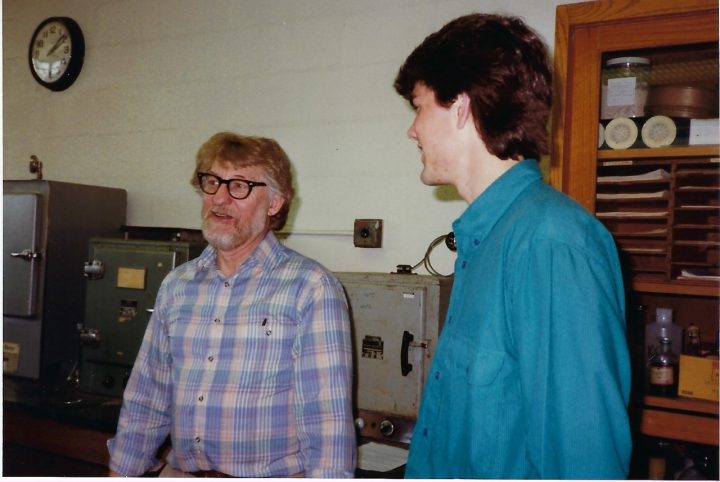Hamline Chemistry Professor Olaf (Ole) Runquist (1931-2021) carried his fascination with science and the experimental approach to answering hard questions from the classroom into every aspect of life.
Runquist brought countless students along on these journeys, creating research questions that could be investigated from the top window in the tower of Old Main on the Hamline campus or a lab overlooking the East River in New York City. He imagined connections between the behavior of molecules and organisms in ways the pointed to an underlying systemic understanding of nature.
In the small town of Lohrville, Iowa, Runquist created memories that lasted a lifetime. He earned an undergraduate degree at Iowa State University, 65 east of his hometown, before moving to the Twin Cities for graduate school. He completed his Ph.D. in organic chemistry at the University of Minnesota and began teaching at Hamline University in St. Paul in 1957. He met his wife, Jane Ann, who hailed from the neighboring community of Lake City, Iowa. They were married for nearly 70 years.
Like many of his science colleagues at Hamline, Runquist distinguished himself both as a teacher and researcher. His contributions to numerous chemistry textbooks and manuals codified his approach to instruction. In the field of organic chemistry, he opposed the tradition of learning chemical equations and molecular transformations by rote. Instead of memorizing hundreds (or even thousands) of pathways, he demonstrated a handful of approaches that could be used to analyze a system of equations. He paired the analysis with a comprehensive understanding of synthesis steps that would be adaptable to almost any pathway. He drew on the wider approach to learning that formed the basis of the Hamline liberal arts curriculum. Runquist’s students who went on to graduate school, industry, and medicine realized what a gift this approach was when the compared notes with others who had memorized their organic chemistry but could not explain what they had learned.
Runquist authored dozens of scientific articles, impressive both for the breadth of topics, but also because many of them were co-authored with former students. His research approach provided additional lessons in iterative approaches to data analysis and computer modeling, starting in the early days of programming that could be done on the campus mainframe by chemistry students working in the small lab above the heating plant. He had a longstanding interest in connections between his field of organic chemistry and the intractable complexities of systemic lupus erythematosus (SLE), an autoimmune disorder with especially challenging diagnostic features and few effective treatments. He collaborated with scientists in multiple departments across several universities and research hospitals, including the Hospital for Special Surgery in Manhattan.
Runquist had a passion for exploring and a sense of adventure that took him and his family on trips to the Boundary Waters Canoe Area and to their small cabin in northern Minnesota. During his career, he used the opportunity of sabbatical leave from Hamline to bring his family along as he found teaching opportunities at various colleges in Scotland and England. As a result, Jane Ann once met the Queen of England when the Runquists were living near Winsor Castle. As they traveled across North America and Europe, Runquist was never shy about engaging strangers, often sharing with his newly found friends the details of his childhood in Iowa.
When he was not teaching, and especially after retirement in 1998, Runquist enjoyed cabin life and could spend hours on the lake in one small boat or another, paddling and fishing. He honed his masonry skills one rock at time, building countless stone walls at the cabin. His love of music often landed him in the front row for Minnesota Opera performances and in the concert hall for St. Paul Chamber Orchestra concerts.

